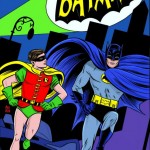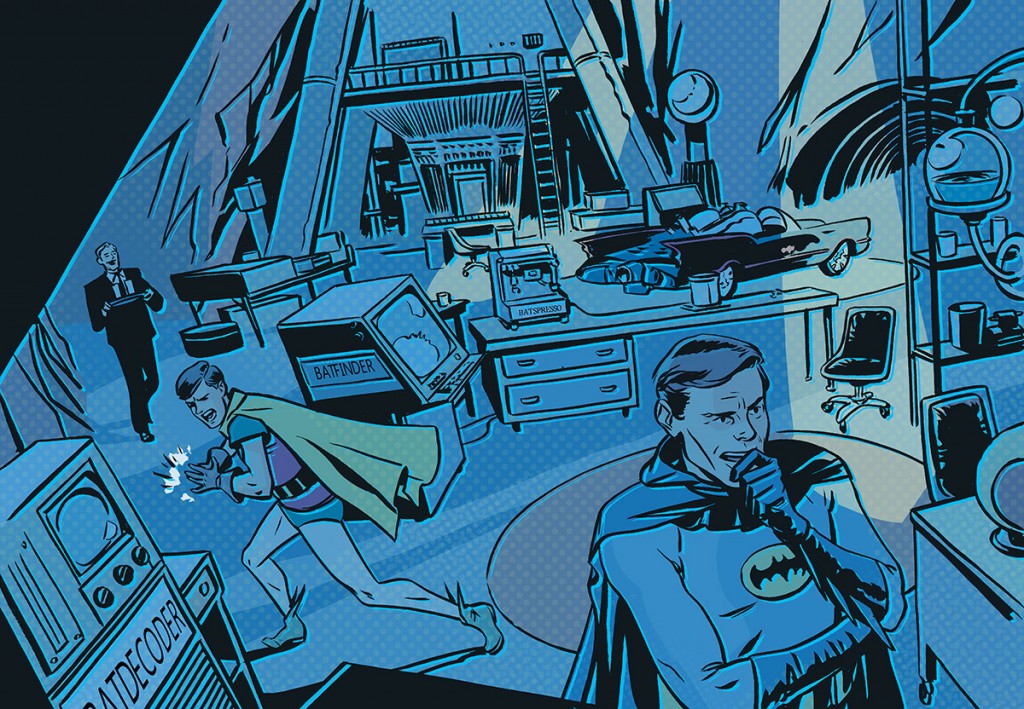“We did our best to keep the digital reading experience fun” writer Jeff Parker and artist Jonathan Case on the secrets behind DC Comic’s first digital interactive comic Batman ’66
 “KAPOW!” This week saw the release of Batman ’66 DC’s first comic to feature it’s new DC2 Interactivity. A brilliant mash up of the 1960s TV show camp and humour with the added bonus of cutting edge digial technology. Keen to find out more about this wierd and wonderful combo we contacted writer Jeff Parker and artist Jonathan Case to get the lowdown on DC’s first foray into the world of interactive comics and the best way to make an ultra-modern comic feel like a 1960s TV show – right down to the OTT sound effects! “BOOSH!”
“KAPOW!” This week saw the release of Batman ’66 DC’s first comic to feature it’s new DC2 Interactivity. A brilliant mash up of the 1960s TV show camp and humour with the added bonus of cutting edge digial technology. Keen to find out more about this wierd and wonderful combo we contacted writer Jeff Parker and artist Jonathan Case to get the lowdown on DC’s first foray into the world of interactive comics and the best way to make an ultra-modern comic feel like a 1960s TV show – right down to the OTT sound effects! “BOOSH!”

How did you get involved with Batman 66 and what appealed to you about working on this title? Was it the digital angle or the retro theme?
JP: I believe they asked me because they saw a picture of Adam West on my studio wall that I’d gotten as a kid. I didn’t waste any time replying though, I accepted the job immediately which I usually don’t do. Once in a while a project comes along that eight year old me would be over the moon about, and I feel I have to take those jobs for him and to connect back with him. This is probably the highest example of that.
JC: I actually didn’t know they had plans for digital when I took the project. Jeff Parker just asked me if I’d want to do a few pages for this Batman comic based on the ’66 show. I really enjoy Jeff as a writer and a friend, and we both do have an appreciation for all things retro. I’m also interested in doing kid-friendly material, so this was a good fit on all counts.
We loved the idea of having DC’s first digital interactive title being a throwback whose idea was that and how much fun was it writing in that style?
JP: I think everyone realized that with the style of the show and the animated sound effects we had a good opportunity to do something that played into that with digital. I’m fairly certain though Hank Kanalz was the one who realized it immediately.
It is a blast writing in a way where you abandon all cynicism and don’t cater to a slightly jaded audience. Because that would make it something it’s not. It’s a property that winks at the readers, yet is also very sincere. And that’s a kind of freedom, a place where you can do something many of the other books actually can’t do, they can’t embrace that tone anymore.
JC: The plan from the get-go was to set it in the era of the TV show. From there, I just wanted to make it feel like a comic from the ’60s, vs. what they actually looked like. I didn’t have a particular affinity for the show, but I have done a lot of work in that era. My first GN, Dear Creature, is set in ’62, and it has a sort of romantic/comedic heart that’s comparable to the idealism of say, Adam West Batman. Green River Killer also has a few parts set in the ’60s.
Did you have to do any kind of research to get the tone right or did you already have an affinity for that era? And Jonathan how did you come up with the brilliant off-set/plate shift colour scheme which it gives it it’s distinctive look?
JC: I looked at a lot of photo reference, looked at the show. It has a very particular use of color, and I just wanted to do something that would put readers in that bright, nostalgic place that says, look: I’m a comic book, and I’m proud of it.
JP: I didn’t really need to research, but it’s certainly a good time watching the shows- which I mainly do to get the character’s voices right.
Did you prefer doing a story from that era than modern Batman?
JP: I recently wrote a modern Batman story for the digital feature, a very street-level and serious Batman, and had a great time with that too. I like them all, I actually have a preference. I want them all to exist because I think there are readers in all camps who need to be served.
JC: Actually, yes. I’m fine with the darker Batman, but I’m not steeped in superhero lore, since I didn’t grow up reading comics. Being able to exercise creative freedom on a non-canon book is nice. Plus, like I said, I enjoy making comics that have a sense of humor. I get tired of any art form, be it music, movies, whatever, that has no sense of humor about itself.
Were there any rules you felt you needed to operate within to make it work? i.e. did you ever think ‘this is too campy’?!
JP: I felt it’s important to not begin with a funny premise as if humor is the end goal. It helps that I mistrust the very idea of a funny premise. The stories should have a lot of humor in them, but it’s not a comedy, it’s something else. Something that revels in what it is and can get away with, that is cool and fun and exciting and unabashed. I want it to not replicate the show you saw, but the way you felt when you first saw it.
As for too campy- maybe in things like I like the riddles to actually make sense and not be Robin pulling them together out of nowhere, I think it works best with a bit more story logic. Like it had in the earliest episodes.
Did you have to write the script in a different way to accommodate the interactive elements or did you leave that up to Jonathan Case? Did you have to have a different writer/artist relationship compared to a print title?
JC: We talked through the script together, Jeff, Jim (our editor), and John of ComiXology. I basically did all the art with print in mind first and foremost, then expanded/reworked areas for digital. I did the inks traditionally, scanned and colored them, and after that, I did the additional work for digital.
For more information on Jonathan’s techniques check out our exclusive look behind the scenes!
JP: It’s a tricky way to write, we’re still learning as we go. I don’t want to make a ton of extra work on the artists. It helps if the artists are good with digital already, well-versed in Photoshop or Manga Studio programs.
What do you make of digital comics as a medium? Are you an iPad Comics reader yourself and if so what books do you like and rate and how do you think Batman 66 compares to them?
JP: I’m starting to read on the iPad finally, the first thing I bought was Paul Tobin and Colleen Coover’s Bandette. That might be a bit closer to B66 in spirit than another really impressive one I recommend, which is Gabriel Hardman’s Kinski. I’m also getting into the comics in Thrillbent.com ‘s group, like The Eighth Seal by Tynion and Rock, I think they’ve figured out some strengths of telling the story digitally and need to be watched.
JC: It has huge potential, and it will only get better. I think the main hurdle with Guided View right now is keeping the pace moving. It’s easy to get bogged down with too many taps required to progress the narrative. Reading on phones is tricky, I think, because it encourages things to be read panel-by-panel, and you lose some of the reading experience of panels interacting with each other. But there’s a lot of comics that can work one panel at a time. With ‘66, we did our best to keep the digital reading experience fun- we’ll see how people like it. So far, the response has been pretty positive.
As far as people doing it well, Mark Waid is an obvious pick!
How long will Batman ’66 run and how long will you be writing it?
JP: Hopefully it will go on for a good long time, initial orders were great and immediately made it necessary for me to start working farther ahead. I want to give artists plenty of time to show off. I plan to be involved for quite a while, it’s too much fun.
Do you have a wish list of characters you want to include and why start with the Riddler as your first villain?
JP: I really look forward to getting to the point where we can bring in characters who never appeared on the show, like Two-Face or Poison Ivy. We have to establish the ones we saw first. Riddler I felt should be first because he was on the show, and it really set the tone that I liked. Villains that are fun and formidable.
JC: I’d love to draw Romero’s Joker in a story. People responded well to that launch art.
Finally I love the use of sound effects in Batman 66, what’s your favourite sound effect to use in a script and why?
JP: I have a BOOSH! coming up that I’m very fond of. Some is love of onomatopoeia, and some is just that the word looks really good as an effect.
JC: That’s all [letterer] Wes Abbott, but the one coming to mind is CAT-ZAM!
Batman ’66 is available now via ComiXology or from the DC Comics app for just £0.69/$0.99




EXCLUSIVE: Behind the scenes look at in-progress pages with Batman ’66 artist Jonathan Case | Pipedream Comics
July 9, 2013 @ 8:05 pm
[…] ← “We did our best to keep the digital reading experience fun” writer Jeff Parker a… […]
Preview: DC Comics let Teen Titans Go! in all new DC2 digital comicPipedream Comics
November 26, 2013 @ 7:06 am
[…] in the footsteps of Jeff Parker and Jonathan Case’s Batman ’66 DC2 uses the ComiXology’s Guided View technology to layer dynamic artwork onto digital comic […]